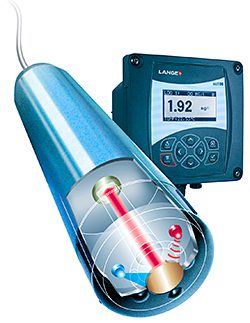
QUINN Glass, a major contract bottle manufacturer and filler, has optimised bottle throughput by switching from electrochemical to optical dissolved oxygen monitoring at the on-site wastewater treatment plant in the company’s Elton facility in Cheshire, UK. Every hour of maintenance stoppage on the treatment plant represents a 1 hour delay on the 5 line filling hall. At speeds of 24,000 – 60,000 bottles per hour, this can translate to a throughput loss of 110,000 – 300,000 bottles.
Six Sigma process efficiency lies at the heart of the process and the switch to optical dissolved oxygen probes, which offer an 80% reduction in maintenance downtime in comparison with traditional electrochemical technology, has enabled the plant to maximise production.
QUINN Glass both manufactures and contract fills/packs glass containers for some of the world’s leading food and beverage brands. As one of the two newest glass plants within the UK, the Elton facility combines bottle manufacture with a state of the art bottle filling plant, Europe’s largest automated bonded warehouse and an on-site wastewater treatment facility.
Operating on 13 glass container manufacturing lines, the Elton site can produce 7 million glass containers in any 24hr period. The filling hall houses 3 beer and fab lines (maintaining speeds of up to 60,000 bottles per hour) and 2 wine and spirit lines (maintaining 24,000 bottles filled per hour). Optimising throughput efficiency is a core goal for the plant and with bottling volume increasing year on year, the company’s vision for 2016 is to expand wine sales from 128 million litres to 230 million litres over the 4 year period. At the centre of such plans lies a serious investment commitment to the facility resulting in a highly automated and partly robot controlled factory for streamlined operational throughput and a green scheme to not only minimise plant impact but also improve the local environment.
Central to the environmental programme is a biological wastewater treatment facility with a 260m3 per hour capability, operating 24/7 between 3 staggered Sequential Batch Reactors (SBR). The clear surface water from the post-treatment process is collected in an attenuation pond, filtered through reed beds and discharged by consent to Hoole Pool Gutter (which ultimately links up to the estuaries of the Mersey).
Matt Tait, Site Facilities Manager, manages the water treatment plant. He says “The effluent load from QUINN Glass would be too costly to have treated externally through our regional wastewater utility. With 1000m3 wastewater being treated every day, the estimated cost would be a staggering £16million a year, so the installation of an on-site treatment plant in 2005 not only saves us a vast amount of money but enables the plant to control and prevent any impact on the local environment.
“The treatment begins with raw process effluent water pumped 25m uphill to the SBR plant. Flow rate is measured to determine the treatment volume with excess volumes diverted to a special on site lagoon (holding up to 6000m3 of extra capacity wastewater). The stream then passes through an on-line total organic carbon (TOC) analyser as a guide to the degree of treatment required. If a high organic overload is present, the feed is diverted to a holding tank from where it can be drip-fed into the main treatment process.
“In the raw feed water tank, course screening removes any large particulates, pH is measured continuously and the liquor dosed with caustic or acid to ensure the optimum pH of 6-9 is achieved – a condition promoting bacterial efficiency. An on-line differential pH sensor from HACH LANGE has been specifically chosen because of its low drift (resulting from isolation of the reference electrode from the sample matrix).”
SBR aeration cycle
Aeration begins with wastewater fed to one of the 720m3 SBR bioreactor tanks, each running 24/7, 365 days a year. Oxygen monitoring is a critical part of this process. With aeration representing typically 50% of the total energy cost of water treatment, an excess supply of oxygen (above 4mg/L) must be avoided. In contrast, if the oxygen supply is insufficient (under 2mg/L) the survival rate of aerobic bacterial seed and breakdown efficiency is seriously compromised.
Measurement accuracy is not the only factor influencing choice of the detection system – maintenance downtime for on-line instruments must be minimal to ensure streamlined 24/7 continuous operation.
Traditional oxygen control of aeration
Traditional electrochemical oxygen sensors are based on a concentric ring electrode assembly surrounded by a charge carrying electrolyte and covered by an oxygen porous membrane. Installed electrodes are pre-polarised for up to 45 minutes in the sample to stabilise the background signal before use. Oxygen arrives and reacts at the electrode surface and its consumption releases a flow of electrons detected across the electrode pair. To replace the consumed oxygen, a constant flow of sample is essential to renew the surface and maintain the signal. In addition, the membrane integrity is critical: if the membrane splits and becomes too porous, current leakage causes a saturated flat-line response, while insufficient porosity resulting from a particulate/fibre blocked surface causes at best, a sluggish response and at worst, no signal at all. With metal electrodes susceptible to interference and poisoning by the matrix itself (from compounds including H2S, methane, metals which oxidise at the same potential) sensors are prone to drift and need frequent maintenance.
The regular 1 hour downtime associated with electrode removal, cleaning, change of electrolyte and membrane, re-polarisation in the tank and final re-calibration is a serious drawback for electrochemical sensors.
QUINN Glass challenged water analysis specialists HACH LANGE to provide a reliable plug and play, low maintenance in-situ system to cut down the service and maintenance time associated with traditional electrochemical based systems and LDO probes were recommended, mounted on sliding poles for simple probe insertion and removal.
LDO yields maximum uptime
Optical LDO (luminescent dissolved oxygen) based measurement overcomes the maintenance limitations of electrochemical systems. In simple terms, blue light is shone onto the surface of a luminescent layer at the tip of the probe. With changes in energy at the surface, red light is emitted which is monitored for intensity and speed of return. When oxygen is present, energy is lost at the layer which reduces the intensity and increases return speed of the emitted red light. There is no requirement for electrode polarisation, no electrolyte or membrane replacement, no flow dependence or interferences and because the probes are factory calibrated and ready for use. This leads to a proven 80-85% reduction in maintenance downtime (simply a replacement of the sensor cap every 2 years and an infrequent wipe down with a damp cloth).
As Matt continues “Each LDO probe is mounted on a 2.3m pole approximately 1m below the water surface in the SBR tank. We monitor the oxygen graphically on our computer and the trending is used to pre-gauge the COD load (where the oxygen is slow to reach the 2mg/L treatment threshold, oxygen mixing is inadequate and COD would be excessive for bacterial efficiency).We have 2 set alarm points: under 2mg/L a first alarm indicates anaerobic conditions which would kill the seed bacteria and over 4mg/L level, a second high range alarm warns us to stop the aeration and save energy.”
Installation in the SBR tanks
Summarising the key benefit of the LDO technology Matt says “Our Six Sigma management strategy is not just looking at one part of the process but the process a whole. Downtime at the effluent treatment stage causes a serious knock-on effect at earlier stages such as stoppage of the filling hall. By transferring from traditional electrochemical based oxygen monitoring to LDO technology there is minimal need to stop the SBR tanks for maintenance which prevents delays in the filling hall and enables much better throughput for the plant.”








